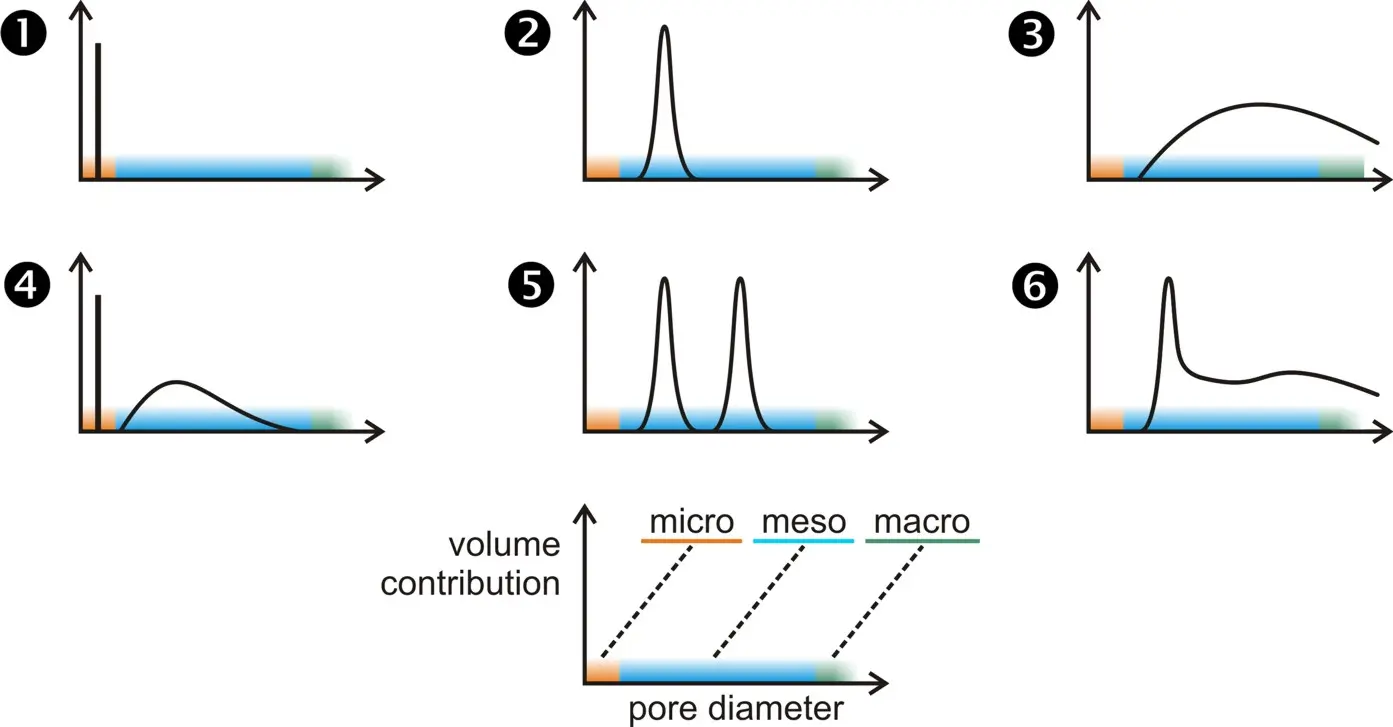Multimodal Porous Particles

At a glance
- Project leader : Dr. Dominik Brühwiler
- Project team : Samuel Gallagher, Dr. Michael Reber, Nicola Zucchetto
- Project budget : CHF 413'000
- Project status : completed
- Funding partner : SNSF (SNF-Projektförderung / Projekt Nr. 172805)
- Contact person : Dominik Brühwiler
Description
Ordered silicate-based porous materials have been at the forefront of research efforts in various fields, including heterogeneous catalysis, drug delivery, adsorption and separation, environmental remediation, photonics, optoelectronics, and sensing. Conventional ordered porous materials, such as zeolites or mesoporous silica, feature a primary pore size that largely defines their respective structural properties. In many cases, the unimodal pore size distributions of these materials are, however, considered a disadvantage. Diffusion is hindered in small pores, whereas the presence of large pores leads to a reduced surface area. In the context of loading a porous host with guests, the uptake is inefficient in small pores, but leaching of the guests becomes an issue in hosts with large pores.
The combination of differently sized pores and various pore systems in a single particle while controlling important properties such as surface functionality and particle size is highly desirable, but challenging. The characterization of such multimodal porous particles is of similar complexity and requires the interplay of multiple methods. The objective of this project is the development of new pathways for the synthesis and characterization of multimodal porous materials, primarily core-shell, hybrid, and hollow particles. Materials of the core-shell type will be designed with functional cores surrounded by silica shells with tailor-made porosity. Hybrid particles are prepared by selective and partial pseudomorphic transformation to combine one-dimensional and three-dimensional pore structures, whereas hollow particles result from hard templating and pseudomorphic transformation.
The multimodal porous particles prepared in this project will be used to investigate the storage and release of substances in function of the pore structure by means of in situ fluorescence monitoring. Furthermore, a hard templating approach will be employed to prepare multimodal porous organic polymer particles with large surface area. The combination of this approach with molecular imprinting is expected to yield materials with efficient molecular recognition capabilities.The project aims to expand the structural diversity of porous materials and to provide concepts for the design of multimodal porous particles with properties that are optimized for specific applications. The availability of multimodal porous materials with well-defined structure will lead to a refinement of characterization methods, in particular in the field of gas sorption. By using the multimodal silicate-based materials as hard templates and transferring the defined multimodal porosity to organic polymers, the samples prepared in the course of the project cover a wide range of chemistries. This large structural and chemical diversity is the key to tailor-made porous particles and to an effective utilization of these materials in a wide range of applications.
Publications
-
Calzaferri, Gion; Gallagher, Samuel H.; Brühwiler, Dominik,
2022.
Microporous and Mesoporous Materials.
330(111563).
Available from: https://doi.org/10.1016/j.micromeso.2021.111563
-
Calzaferri, Gion; Gallagher, Samuel; Brühwiler, Dominik,
2021.
Microporous and Mesoporous Materials.
312(110744).
Available from: https://doi.org/10.1016/j.micromeso.2020.110744
-
Gallagher, Samuel H.; Schlauri, Paul; Cesari, Emanuele; Durrer, Julian; Brühwiler, Dominik,
2021.
Nanoscale Advances.
3(22), pp. 6459-6467.
Available from: https://doi.org/10.1039/D1NA00599E
-
Gallagher, Samuel; Trussardi, Olivier; Lipp, Oliver; Brühwiler, Dominik,
2020.
Hollow silica cubes with customizable porosity.
Materials.
13(11), pp. 2474.
Available from: https://doi.org/10.3390/ma13112474
-
Zucchetto, Nicola; Brühwiler, Dominik,
2018.
Chemistry of Materials.
30(20), pp. 7280-7286.
Available from: https://doi.org/10.1021/acs.chemmater.8b03603
-
Reber, Michael; Zucchetto, Nicola; Brühwiler, Dominik,
2018.
Synthesis of advanced mesoporous materials by partial pseudomorphic transformation.
Chimia.
72(3), pp. 158-159.
Available from: https://doi.org/10.2533/chimia.2017.158
-
Zucchetto, Nicola; Reber, Michael; Pestalozzi, Lias; Schmid, Ramon; Neels, Antonia; Brühwiler, Dominik,
2018.
The structure of mesoporous silica obtained by pseudomorphic transformation of SBA-15 and SBA-16.
Microporous and Mesoporous Materials.
257, pp. 232-240.
Available from: https://doi.org/10.1016/j.micromeso.2017.08.046